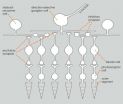(Press-News.org)
VIDEO:
Ganglion cells preferentially form synapses with those amacrine cells whose dendrites run in the direction opposite -- seen from the ganglion cell - to the preferred direction of motion (amacrine...
Click here for more information.
The sensory cells in the retina of the mammalian eye convert light stimuli into electrical signals and transmit them via downstream interneurons to the retinal ganglion cells which, in turn, forward them to the brain. The interneurons are connected to each other in such a way that the individual ganglion cells receive visual information from a circular area of the visual field known as the receptive field. Some ganglion cells are only activated, for example, when light falls on the centre of their receptive fields and the edge remains dark (ON cells). The opposite is the case for other ganglion cells (OFF cells). And there are also ganglion cells that are activated by light that sweeps across their receptive fields in a particular direction; motion in the opposite (null-) direction inhibits activation.
Starburst amacrine cells, which modulate the activity of the ganglion cells through inhibitory synaptic connections, play an important role in this direction selectivity. The same research group at the Max Planck Institute in Heidelberg demonstrated a number of years ago that starburst amacrine cells are activated by moving stimuli. Each branch in the circular dendrite tree reacts preferentially to stimuli that move away from the cell body; movements in the opposite direction, towards the cell body, inhibit its activity. In the central area around the cell body dendrites function only as receivers of synaptic signals, while the dendrites on the periphery act as transmitters as well – and, therefore, double as axons. Whether these dendrites cause the direction selectivity in the ganglion cells or whether the ganglion cells "compute" it using other signals was unclear up to now.
Max Planck researchers Kevin Briggman, Moritz Helmstaedter and Winfried Denk have now discovered that, although the cells themselves are symmetrical, the synapses between retinal ganglion cells and starburst amacrine cells are distributed asymmetrically: seen from the ganglion cell, the starburst cell dendrites connected with it run in the direction opposite to the preferred direction of motion. "Ganglion cells prefer amacrine-cell dendrites that run along the null-direction," says Winfried Denk.
According to previous studies by Winfried Denk and his research group, the electrical characteristics of the dendrites, which emerge starlike from the cell bodies of amacrine cells, play a crucial role here. The further they are located from the centre of the cell toward the edge, the easier they are to excite; therefore, stimuli are transmitted preferentially in this direction. This mechanism does not require but is helped by inhibitory influences between neighbouring amacrine cells, known as lateral inhibition. "A ganglion cell can thus differentiate between movements from different directions simply by making connections with certain starburst amacrine cell dendrites - namely those that prevent activation of the ganglion cell in null-direction through their inhibitory synapses. These are precisely the amacrine cell dendrites that run along this direction," explains Winfried Denk.
Functional and structural analysis
This discovery was made possible by combining two different microscopy methods. The scientists succeeded, first, in determining the preferred motion direction of the ganglion cells using a two-photon fluorescence microscope. A calcium-sensitive fluorescent dye indicated in response to which stimuli calcium flows into the cells - a process that signals electrical activity in cells.
They then measured the exact trajectory of all of the dendrites of these ganglion cells and those of connected amacrine cells with the help of a new electron microscopy method known as serial block face electron microscopy. This process enabled them to produce a volumetric image by repeatedly scanning the surface of a tissue sample using the electron beam of a scanning electron microscope. A thin "slice" is shaved off the sample surface after each scan is complete, using an extremely sharp diamond knife. These slices are thinner than 25 nanometers, just about one thousandth of the thickness of a human hair.
The high three-dimensional resolution of this method enabled the scientists to trace the fine, densely packed branched dendrites of retinal neurons and clearly identify the synapses between them. The complete automation of the imaging process enables them to record data sets with thousands and even tens of thousands of sections "while on holiday or attending a conference," says Winfried Denk. "For the first time, minute cell structures can now be viewed at a high resolution in larger chunks of tissue. This procedure will also play an indispensable role in the clarification of the circuit patterns of all regions of the nervous system in the future."
INFORMATION:
Original work:
Kevin L Briggman, Moritz Helmstaedter, Winfried Denk
Wiring specificity in the direction-selectivity circuit of the retina
Nature, March 10, 2011
New microscope decodes complex eye circuitry
2011-03-10
ELSE PRESS RELEASES FROM THIS DATE:
Physicists measure current-induced torque in nonvolatile magnetic memory devices
2011-03-10
ITHACA, N.Y. - Tomorrow's nonvolatile memory devices – computer memory that can retain stored information even when not powered – will profoundly change electronics, and Cornell University researchers have discovered a new way of measuring and optimizing their performance.
Using a very fast oscilloscope, researchers led by Dan Ralph, the Horace White Professor of Physics, and Robert Buhrman, the J.E. Sweet Professor of Applied and Engineering Physics, have figured out how to quantify the strength of current-induced torques used to write information in memory devices ...
NASA and other satellites keeping busy with this week's severe weather
2011-03-10
Satellites have been busy this week covering severe weather across the U.S. Today, the GOES-13 satellite and NASA's Aqua satellite captured an image of the huge stretch of clouds associated with a huge and soggy cold front as it continues its slow march eastward. Earlier this week, NASA's Tropical Rainfall Measuring Mission satellite captured images of severe weather that generated tornadoes over Louisiana.
Today the eastern third of the U.S. is being buffered by a large storm that stretches from southeastern Minnesota east to Wisconsin and Michigan, then south through ...
International panel revises 'McDonald Criteria' for diagnosing multiple sclerosis
2011-03-10
International Panel Revises "McDonald Criteria" for Diagnosing MS -- Use of new data should speed diagnosis -- Publication coincides with MS Awareness Week
An international panel has revised and simplified the "McDonald Criteria" commonly used to diagnose multiple sclerosis, incorporating new data that should speed the diagnosis without compromising accuracy. The International Panel on Diagnosis of MS, organized and supported by the National MS Society and the European Committee for Treatment and Research in Multiple Sclerosis, was chaired by Chris H. Polman, MD, PhD ...
MIT scientists identify new H1N1 mutation that could allow virus to spread more easily
2011-03-10
CAMBRIDGE, Mass. -- In the fall of 1917, a new strain of influenza swirled around the globe. At first, it resembled a typical flu epidemic: Most deaths occurred among the elderly, while younger people recovered quickly. However, in the summer of 1918, a deadlier version of the same virus began spreading, with disastrous consequence. In total, the pandemic killed at least 50 million people — about 3 percent of the world's population at the time.
That two-wave pattern is typical of pandemic flu viruses, which is why many scientists worry that the 2009 H1N1 ("swine") flu ...
New study proves the brain has 3 layers of working memory
2011-03-10
Researchers from Rice University and Georgia Institute of Technology have found support for the theory that the brain has three concentric layers of working memory where it stores readily available items. Memory researchers have long debated whether there are two or three layers and what the capacity and function of each layer is.
In a paper in the March issue of the Journal of Cognitive Psychology, researchers found that short-term memory is made up of three areas: a core focusing on one active item, a surrounding area holding at least three more active items, and a ...
Giving children the power to be scientists
2011-03-10
Children who are taught how to think and act like scientists develop a clearer understanding of the subject, a study has shown.
The research project led by The University of Nottingham and The Open University has shown that school children who took the lead in investigating science topics of interest to them gained an understanding of good scientific practice.
The study shows that this method of 'personal inquiry' could be used to help children develop the skills needed to weigh up misinformation in the media, understand the impact of science and technology on everyday ...
Researchers selectively control anxiety pathways in the brain
2011-03-10
A new study sheds light--both literally and figuratively--on the intricate brain cell connections responsible for anxiety.
Scientists at Stanford University recently used light to activate mouse neurons and precisely identify neural circuits that increase or decrease anxiety-related behaviors. Pinpointing the origin of anxiety brings psychiatric professionals closer to understanding anxiety disorders, the most common class of psychiatric disease.
A research team led by Karl Deisseroth, associate professor of psychiatry and behavioral sciences and bioengineering, identified ...
Researchers develop synthetic compound that may lead to drugs to fight pancreatic, lung cancer
2011-03-10
DALLAS – March 10, 2011 – Researchers at UT Southwestern Medical Center have identified a chemical compound that may eventually lead to a drug that fights cancers that are dependent on a particular anti-viral enzyme for growth.
The researchers are testing the compound's effectiveness at fighting tumors in mice. If it is successful, they will then work to develop a drug based on the compound to combat pancreatic and non-small cell lung cancer, two cancer types in which this particular enzyme, TBK-1, often is required for cancer cell survival.
"Our prediction is that ...
Report: International collaboration between researchers results in greater recognition
2011-03-10
U.S. researchers who collaborate with international scientists are more likely to have their work cited than peers who do not utilize overseas expertise, according to a new study released this week by Rice University's Baker Institute for Public Policy. U.S. collaborators with international scientists are also more likely to receive greater recognition and produce work with greater impact.
The study, "International Stem Cell Collaboration: How Disparate Policies Between the United States and the United Kingdom Impact Research," was authored by Kirstin Matthews, a fellow ...
New UF study shows some sharks follow 'mental map' to navigate seas
2011-03-10
GAINESVILLE, Fla. — A new study led by a University of Florida researcher uses tracking data of three shark species to provide the first evidence some of the fish swim directly to targeted locations.
Researchers found tiger and thresher sharks showed the ability to orient at large distances, with tiger sharks swimming in direct paths at least 4 miles away and reaching specific resource areas about 30 miles away, said lead author Yannis Papastamatiou, a marine biologist in the division of ichthyology at the Florida Museum of Natural History on the UF campus.
A research ...


